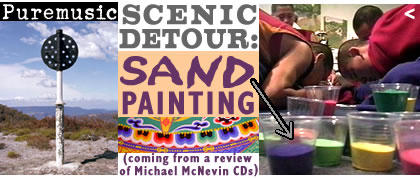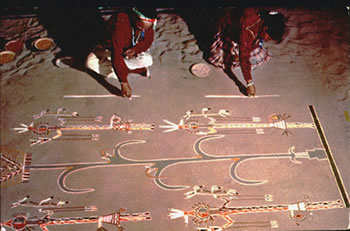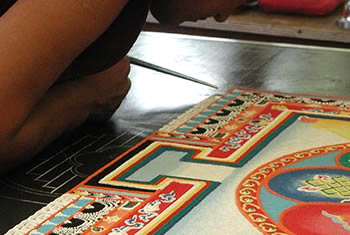
The Navajo name for sandpainting, iikaah, translates to "place where gods come and go." Sandpainting has been used for centuries in Navajo religious rituals, including ceremonies for summoning forces to intercede and restore a patient's hozho, or balance.

A Navajo sandpainting is usually between 6 and 8 feet in diameter, though
it may be as large as 20 feet (requiring several men and women to finish
it in the allotted day). The patient sits in what will become the painting's
center and faces the open door of the hogan, which always faces east.
For practical reasons, work begins in the center and continues outward
in a "sunwise" pattern (east to south to west to north and back
to east).
As the painting is created, the energies being summoned will arrive and
infuse it with their healing power. The singer, or medicine man, transfers
these energies to the patient from the painting, dispelling the evil and
restoring the balance, also shielding against further threats of a similar
nature. When the ritual is completed, the patient leaves the sandpainting
and all the sands are swept away in a reverse order from the creation.
The sand is then either buried outside or scattered to the four directions.
Sandpaintings are not necessarily used for curing the ill. In fact, the
heart of the Navajo religion is the Blessing Way Ceremony, giving hozho
to many things: a newly born child, a new home, a new planting, a new
job, a marriage, etc. (Much of this information was lifted from a more
detailed look at Navajo sandpainting that can be found here.)

The Tibetan ritual of painting with colored sand comes from Tantric Buddhism.
In Tibetan, the art is known as dul-tson-kyil-khor, which means
literally "mandala of colored powders." Mandala is Sanskrit
for circle.
After a mandala pattern has been elaborately stenciled onto a flat surface,
colored sand is used to complete the image over a period of several days.
Different sand mandalas convey different meanings: they can be understood
to represent the world and its divine potential or a map of the ordinary
human mind and its quest for liberation. Creating a mandala is believed
to heal and purify on both the universal and personal level, bringing
the earth and its inhabitants into harmony.

The sand is poured onto the outline by using traditional metal tubes called
chak-pur. A monk holds a sand-filled chak-pur in one hand and uses the
other hand to run a metal rod along it, causing the sand to gently vibrate
down and flow out like liquid.
Most sand mandalas are destroyed shortly after their completion. This
is in keeping with Buddhist ideology that everything in life is impermanent,
that nothing lasts forever. (Westerners are challenged to look beyond
the sand mandala's status as an art object, and to see it as a symbol
of the potential for enlightenment.) The sands are swept up from the outside
toward the center, placed into an urn, and poured into a nearby river
or stream where the waters carry healing energies throughout the world.
(See photos of a sand mandala being created here,
and to find more sites that have photos and information about them go
here.)

In the late
1950s, a Frenchman named Arthur Granjean invented the device he called
L'Ecran Magique, or "The Magic Screen." The Ohio Art
Company adopted the patent, developed the toy's now-classic shape and
color, and renamed the magic screen "Etch A Sketch." Since the
Etch A Sketch first went on the market in 1960, over 100 million children
(and adults) in 67 countries have been drawn to its irresistible white
knobs for endless hours of etching fun and meditative discovery.
The reverse side of the glass screen is coated with a mixture of aluminum
powder and plastic beads. The left and right knobs control horizontal
and vertical rods that move a stylus where the two meet. When the stylus
slides through the powder, it scrapes the screen leaving the line you
see. Shaking the device re-mixes the powder, thus clearing the screen.
The Etch A Sketch® name and configuration is a registered trademark of the Ohio Art Company. Their online store is here, and etch-a-sketch.com (with info, kid fun, and a sketch-art gallery) is here.